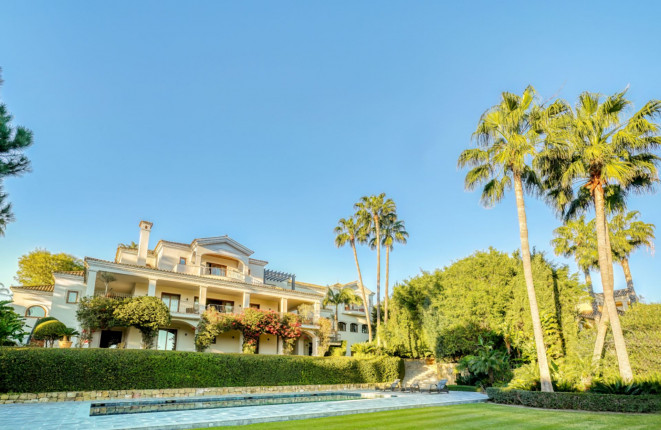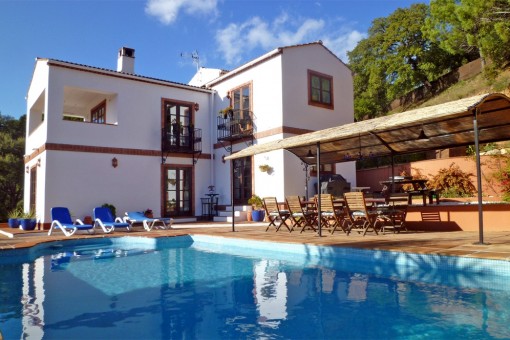1 property for sale in Mijas
1
1
Real estate agent in Mijas, Andalucia
You are looking for a property for sale in Mijas, or have a question regarding our real estate offers in Andalucia? You were not able to find the ideal finca in Mijas?
Then please call us on +34 971 720 164, or send us an email to info@portaandalucia.com. Our Porta Andalucia real estate agents in Mijas will be pleased to asist and will help you find your dream property.
About Mijas and surrounding area:
General:
Mostly unknown in Germany, Mijas (pronounced "Michas"), located roughly halfway between Malaga and Marbella on the famous Costa del Sol, deserves a pint of attention, especially for people who like it more modest. With just over 7500 inhabitants Mijas is still referred to in Spain as a "Pueblo" ("village"), with its wide range of restaurants and shopping options, this location already offers a pinch of small town atmosphere.
The location at 425 m above sea level combines the best of the sea and the mountains and is often compared to a view-point terrace. The white village is nestled within the picturesque
southern slope of the Sierra de Mijas, towering up to 1150 m. With its fragrant pine forests on the other side, it overlooks the only 7 km away bay of Fuengirola and the sparkling Mediterranean Sea.
Thanks to the maritime sector in particular, Mijas has a very large municipal area of 40,000 inhabitants. Of course, one can also enjoy the sensational climate of the Costa del Sol in Mijas with its 2900 hours of sunshine and balanced temperatures. Frosty winters or extreme summer heat is virtually unknown in this area.
Town Attractions:
Mijas is a particularly beautiful example of a "Pueblo Blanco" on the central Costa del Sol, so named because of the dazzling whitewash of traditional houses. Even a little stroll through the narrow streets can make the day interesting. For those who find this too tiring, can also make use of the services of the "Burro - Taxis", traditionally decorated donkeys, which take visitors on a relaxed sightseeing ride through the town.
In its original sense, such an attractive location near a highly touristy region has diverted from its natural state. Day trippers, who do not just want to get to know the beach during their holidays, populate the central areas of the village during the season and find plenty of shopping and refreshment opportunities there. Somewhat off the beaten track, Mijas still presents itself as an enchanting piece of Andalusia, which in addition to the devotedly cultivated townscape also has some further curiosities to offer.
The love for bullfighting amongst the Andalusians has certainly reflected in the historic bullfighting arena, which is comparatively tiny, but quite square - unique amongst the otherwise circular battlegrounds for the "Corrida".
While the arena towers high on the castle hill, the associated bullfighting museum has been set up on the Plaza Virgen de la PeÒa in the lower city. Only a few remnants of walls have survived from the castle built in the 9th century by the rebellious Moors, and a watchtower has been used as a belfry for the 16th-century parish church of Inmaculada Concepcion ("Church of the Immaculate Conception"). Not far away, the viewpoint "Mirador" offers a magnificent view down to the coast.
A veritable show of curiosities is the private museum of Professor Max, who collected miniatures on his extensive travels throughout the world. The Seven Wonders of the World are placed on a toothpick for example, the Last Supper by Leonardo da Vinci on a grain of rice and many more. Since this museum with its approximately 360 exhibits was housed in a type of caravan, it is also known as the "Carromato de Max". Moreover, near the Plaza Virgen de la PeÒa, the Municipal Museum called "Casa Museo" can be found which provides insights into the everyday culture of the local population and also shows altering exhibitions of mostly contemporary artists.
Beaches and surroundings:
Also part of Mijas is a 20-kilometer-long stretch of coastline between the larger towns of Fuengirola and Marbella around the town of La Cala - for simplicity, this section is named "Mijas Costa". In the past, numerous urbanisations were created here, especially settlements with apartment complexes and hotels specially designed for tourists, and even a few camping grounds have settled here. The beaches are predominantly sandy, sometimes pebbly - the colour spectrum ranges from almost bright Caribbean to darker earthy tones.
Some beaches are rather narrow and do not seem so inviting due to the coastal road which is located relatively close in the background. Some beaches like the Playa de la Cala and the Playa Calahonda are a slightly more appealing with a width of about 30 meters and a subtler building structure all around the area.
ndoubtedly, Playa Artola near the urbanisation Cabopino can count itself amongst the most beautiful beaches in the region. The beaches around the sports harbour of this holiday resort, in the direction of Marbella, flows into significant dunes surrounded by fragrant pine trees. This natural sandy beach, known as "Las Dunas" is also often visited by fans of naturism, as a nudist beach.

 Porta Andalucia - Your specialist for holiday properties in Andalucia.
Porta Andalucia - Your specialist for holiday properties in Andalucia.








